Poaching in America
The other day I posted a video and commented on the illegal harvesting of rosewood in Madagascar. It looks like this sad disrespect for trees is happening closer to home as well. Sigh...
The other day I posted a video and commented on the illegal harvesting of rosewood in Madagascar. It looks like this sad disrespect for trees is happening closer to home as well. Sigh...
 Beliefs about characteristics and generalizations of acoustic guitars, and their associated construction techniques and materials, seems to me to be a lot like religion. As an atheist this is weird for me to think about, but we (guitar players) make a lot of leaps of faith based on scant evidence (what we scientists call an "N of one"), what others have told us, and what makes "reasonable sense" to us as individuals. How much of what we believe, prefer, and hear in our instruments is based in tradition, expectations, superstition, illusory correlations, and what we read in books/magazines and on the internet?
Beliefs about characteristics and generalizations of acoustic guitars, and their associated construction techniques and materials, seems to me to be a lot like religion. As an atheist this is weird for me to think about, but we (guitar players) make a lot of leaps of faith based on scant evidence (what we scientists call an "N of one"), what others have told us, and what makes "reasonable sense" to us as individuals. How much of what we believe, prefer, and hear in our instruments is based in tradition, expectations, superstition, illusory correlations, and what we read in books/magazines and on the internet?
Another interesting parallel between acoustic guitar players and religion, although somewhat of a sidenote to this discussion, is that we are inherently conservative; it takes a long time to get us guitar players to change the standards of what is perceived as "normal" or preferable. For example, I'm really interested in seeing how the necessary future use of sustainable "alternatives" tonewoods is embraced by players/consumers. While I love the idea of walnut and cherry guitars that are made from timbers locally and responsibly harvested, given the choice, I'd still take my tried-and-true Honduran mahogany!
I really have great respect and envy for those few folks who have played hundreds and thousand of vintage and new guitars, and for those who build instruments (i.e., and do "experiments" to learn about acoustic properties of materials and construction techniques); those people with lots of data to base their beliefs on. Unfortunately, that's not me (yet?).
Keeping these reservations in mind, here are my guitar beliefs; much like religion, they are based on a small sample size, what people I respect think, and what "makes reasonable sense" given my basic knowledge of physics and lutherie. Some of these beliefs are probably totally irrational, and like religion, we could get into endless and unwinnable debates about all of these points:*
*However, unlike religion, the below points could all be tested experimentally,
and I'd happily change my mind in the face of good evidence.
 Bourgeois neck (from pantheonguitars.com)
Bourgeois neck (from pantheonguitars.com)

 Image source: fretnotguitarrepair.comWith the commercial success of Martin's "Authentic" series, which employs non-adjustable T-bar truss rods in many models (and non-adjustable ebony in others), there's been a renewed discussion in the relative merits of adjustable vs. non-adjustable truss rods. Like with neck joints, my guess is that there is a sonic difference, but this is one place I'd rather err on the side of modernity...I'll take adjustable over not if given the choice, especially if I'm buying a used guitar (like I tend to do).
Image source: fretnotguitarrepair.comWith the commercial success of Martin's "Authentic" series, which employs non-adjustable T-bar truss rods in many models (and non-adjustable ebony in others), there's been a renewed discussion in the relative merits of adjustable vs. non-adjustable truss rods. Like with neck joints, my guess is that there is a sonic difference, but this is one place I'd rather err on the side of modernity...I'll take adjustable over not if given the choice, especially if I'm buying a used guitar (like I tend to do). Herringbone Martin (image from folkwaysmusic.com...lots of nice guitars on their website!)
Herringbone Martin (image from folkwaysmusic.com...lots of nice guitars on their website!)
![]() Ick! (from http://www.acousticguitarforum.com/forums/showthread.php?t=266220)
Ick! (from http://www.acousticguitarforum.com/forums/showthread.php?t=266220)
Last time I chronicled the guitars I started with through college. All of those are long gone, as are most that were acquired during graduate school (1996-2001). But this was an important time; along with furthering my education in psychology, this is really when I started to learn about what to look for in a good guitar and what I tend to like (e.g., mahogany). Student loans really helped with this part of my education! The fact that West Lafayette didn't have a good Martin dealer (and had an excellent Taylor dealer) very much shaped this stage.
 Taylor 414K from 1997.Taylor 420R (1997; serial #970604026) - This came from Klaverenga Guitar & Piano in West Lafayette, where I first heard of Taylor. Sitka and rosewood. Sold it in 2001. Reflecting back on my progression through guitars, my feeling now is that Taylors are a great entry to acoustic guitars...They are very "sweet" sounding and accessible. As I got older I started to gravitate towards more complex-sounding guitars, but for me, it was a great way to get hooked on the acoustic guitar.
Taylor 414K from 1997.Taylor 420R (1997; serial #970604026) - This came from Klaverenga Guitar & Piano in West Lafayette, where I first heard of Taylor. Sitka and rosewood. Sold it in 2001. Reflecting back on my progression through guitars, my feeling now is that Taylors are a great entry to acoustic guitars...They are very "sweet" sounding and accessible. As I got older I started to gravitate towards more complex-sounding guitars, but for me, it was a great way to get hooked on the acoustic guitar. Rickenbacker 360.
Rickenbacker 360.
 1977 Taylor 915.Taylor 915 (1977; serial #37x....last digit missing due to a torn label when the neck was reset) - My first internet guitar purchase; I got this from a fellow in New Jersey in 1999...One of the first 400 guitars Taylor ever built...A maple jumbo with an uber-cool moustache bridge. Sold this on Craigslist in 2008 or so.
1977 Taylor 915.Taylor 915 (1977; serial #37x....last digit missing due to a torn label when the neck was reset) - My first internet guitar purchase; I got this from a fellow in New Jersey in 1999...One of the first 400 guitars Taylor ever built...A maple jumbo with an uber-cool moustache bridge. Sold this on Craigslist in 2008 or so.I've been meaning to do a log of the guitars I've owned across the last 20+ years. This is a pretty daunting task if I try to tackle it all in one big list, so I'll break it up into chunks. To get the ball rolling, I'll start with high school and college (Cal Poly and Grinnell), which goes up to summer of 1996; later editions will cover other eras (split by academic markers: grad school, pre-tenure, post-tenure).
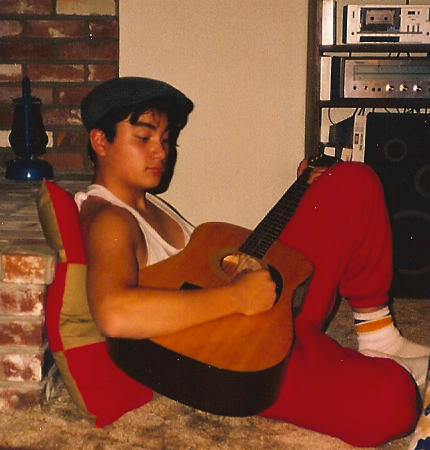 Bad circa 1990 fashion with the Gemini II.
Bad circa 1990 fashion with the Gemini II.
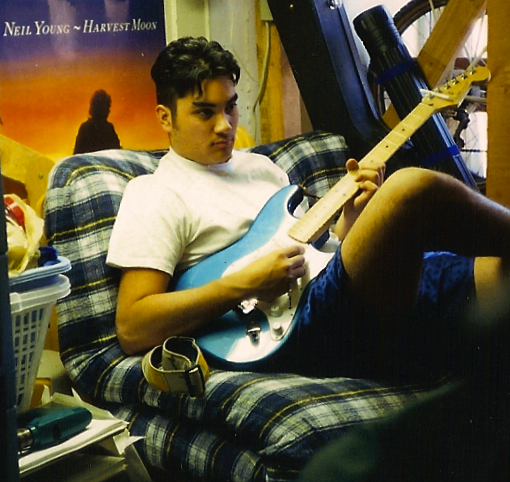
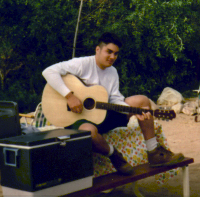 With the Landola jumbo, summer 1993.Landola jumbo...I don't remember the model number (early-90s) - Purchased new in spring 1993 at some shop in San Luis Obispo, Los Osos, or Morro Bay. I'm shocked how bad my memory is! An interesting jumbo guitar, made in Finland, with a solid spruce top and laminated birch back/sides, and matte finish. Landola went on to make a run of acoustic guitars for Peavey (the amp company). Sold it in West Lafayette. Never saw another Landola until the fall 2012 Philly guitar show, where I ran into a similar one. A nice guitar.
With the Landola jumbo, summer 1993.Landola jumbo...I don't remember the model number (early-90s) - Purchased new in spring 1993 at some shop in San Luis Obispo, Los Osos, or Morro Bay. I'm shocked how bad my memory is! An interesting jumbo guitar, made in Finland, with a solid spruce top and laminated birch back/sides, and matte finish. Landola went on to make a run of acoustic guitars for Peavey (the amp company). Sold it in West Lafayette. Never saw another Landola until the fall 2012 Philly guitar show, where I ran into a similar one. A nice guitar.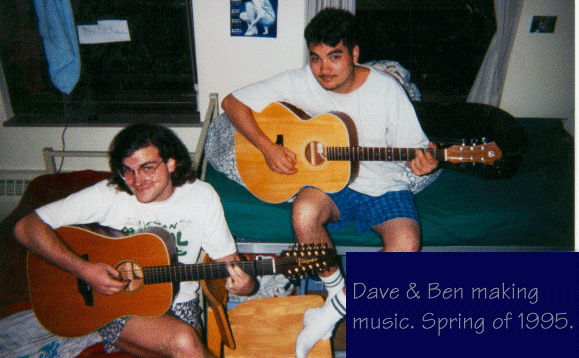 Dave with the Takamine N-1012 and Ben with the Landola jumbo.
Dave with the Takamine N-1012 and Ben with the Landola jumbo.
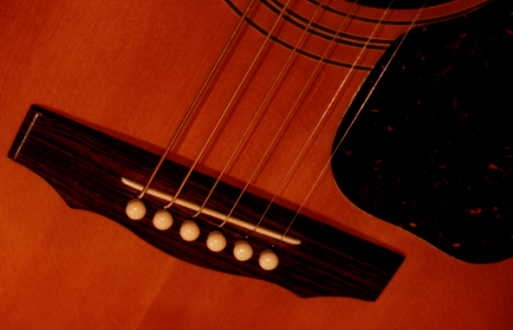 The only picture I could find of the Guild D-40SB.
The only picture I could find of the Guild D-40SB.
Next up...Student loans in grad school = the start of guitar collecting.
I've been working on a personal history of the guitars I've owned (update: see here for Part 1). As a prelude to that series, here are a couple of pictures from my childhood. When my parents say I spend too much money on guitars, they only have themselves to blame.
 Toronto, 1975.
Toronto, 1975.
 My dad's birthday, probably 1980 or 1981.
My dad's birthday, probably 1980 or 1981.
Although you wouldn't know it by these pictures, I stupidly rejected learning how to play guitar as a child and didn't become interested in the instrument until I was 15 or so. I remember taking a class when I was about 5 or 6 in Davis, becoming increasingly frustrated with having to learn "Hot Crossed Buns." If they would have showed me some Hendrix or Tony Rice right from the get-go, maybe I would have stuck with it (and by "showed" I don't mean teaching a 5-year old how to play "Voodoo Chile"...I mean showing that there was someplace it could go beyond dumb kid's songs). I took lessons briefly in high school and then for a semester in college from Roger Lasley, who was the registrar at Grinnell at the time. Having just started guitar lessons again last week, I'm regretting not being more serious about playing as a child/teen.
I'm not lucky enough to have a John Walker guitar and this video isn't helping my GAS for one.
"GAS" = Guitar Acquisition Syndrome
Everyone knows I like guitars; nice acoustic instruments are really my only vice. If a big pile of money fell into my lap, I'd buy the following in a heartbeat:
1. A late-40's to mid-50's Martin D-28. I know that I'll never be able to afford a pre-war D-28, but one from a few years later isn't totally out of the question. Someday.
2. A mid-to-late-30's Gibson L-00 or similar. Something ultra-light, oozing with mojo. Update: ended up with one of the first Waterloo WL-14X guitars available to the public in fall of 2014. How cool are these? And at half the cost of a vintage Gibson, the price is right!
3. A Bourgeois Slope-D, Fairbanks F-35, Santa Cruz Vintage Southerner, Walker Wise River, Collings CJ (new Mass. Street Music custom; update: what they call the "CJ35" now), and a vintage Gibson J-45 or J-50 (pre-1955). Not sure why I'm so into slope-shouldered guitars right now, but I want them. All. (note, a Kopp K-35 isn't on this list because I have one :-)
4. An early-30's Martin OM-18. Probably will never happen, so a newer OM-18GE might be as close as I get. But maybe a late-30's 00-18 or 0-18 could happen some day. Ditto on a pre-war 000-18 and contemporary 000-18 Authentic. A D-18 Authentic wouldn't be too bad either.
 1953 D-28...Click to embiggen. Photo from vintage-instruments.com.
1953 D-28...Click to embiggen. Photo from vintage-instruments.com.
 Sunday, November 4, 2012 |
Sunday, November 4, 2012 |  Post a Comment | tagged
Post a Comment | tagged  collings,
collings,  g.a.s.,
g.a.s.,  gibson,
gibson,  guitar,
guitar,  martin,
martin,  santa cruz guitar company
santa cruz guitar company At the Martin guitar factory, in Nazareth, Pennsylvania. Fuji X100 @ f/2. Converted with Nik Silver Efex Pro.
 Tuesday, May 22, 2012 |
Tuesday, May 22, 2012 |  Post a Comment in
Post a Comment in  photo of the week | tagged
photo of the week | tagged  fuji x100,
fuji x100,  guitar,
guitar,  lutherie,
lutherie,  martin
martin At the Martin guitar factory, in Nazareth, Pennsylvania. Fuji X100 @ f/2. Converted with Nik Silver Efex Pro.
 Tuesday, May 15, 2012 |
Tuesday, May 15, 2012 |  Post a Comment in
Post a Comment in  photo of the week | tagged
photo of the week | tagged  fuji x100,
fuji x100,  guitar,
guitar,  lutherie,
lutherie,  martin
martin At the Martin guitar factory, in Nazareth, Pennsylvania. Fuji X100 @ f/2. Converted with Nik Silver Efex Pro.
 Tuesday, May 8, 2012 |
Tuesday, May 8, 2012 |  Post a Comment in
Post a Comment in  photo of the week | tagged
photo of the week | tagged  fuji x100,
fuji x100,  guitar,
guitar,  lutherie,
lutherie,  martin
martin I got a taste of it playing a '49 D-18 at Vintage Instruments last summer, but spending time with the "Dawg" '56 D-18 has really made me understand that there's something special about old guitars. Admittedly I don't have any experience with pre-war dreadnoughts, but I've now played a few D-18s from the late-40s through mid-50s (a '48, '49, '55, '56, and '57) and I'm starting to see why guitar-geeks go crazy over vintage guitars. Sound is so subjective and hard to describe, but I can say that they *feel* different. Much like your favorite broken-in faded blue jeans, they're worn in just the right places to be comfortable. Your hand knows exactly where it's supposed to be on the neck, following generations of players before you.
I'm a bit concerned that I'm developing a taste for vintage guitars. I'm starting to get it; there is something special about vintage guitars.
 Willie Nelson's well-loved "Trigger"Of course, as I scientist I'm trained to think about various possible explanations. Why are old guitars different? Maybe it's attrition: the best guitars are the ones that made it through the last fifty or sixty years. It's musical survival of the fittest. Great sounding boxes were loved and cherished, while the dogs were cast aside as disposable guitars. I don't really buy this explanation; Martins and Gibsons have never been been cheap. Musicians wouldn't be carelessly casting these aside instruments, even the ones that might sound sub-par. And great sounding guitars would have been played a lot (i.e., used and abused); one can just as easily make a compelling argument that great sounding guitars would have been less likely to have survived.
Willie Nelson's well-loved "Trigger"Of course, as I scientist I'm trained to think about various possible explanations. Why are old guitars different? Maybe it's attrition: the best guitars are the ones that made it through the last fifty or sixty years. It's musical survival of the fittest. Great sounding boxes were loved and cherished, while the dogs were cast aside as disposable guitars. I don't really buy this explanation; Martins and Gibsons have never been been cheap. Musicians wouldn't be carelessly casting these aside instruments, even the ones that might sound sub-par. And great sounding guitars would have been played a lot (i.e., used and abused); one can just as easily make a compelling argument that great sounding guitars would have been less likely to have survived.
If it's not a selection bias, it has to be either the quality of the construction (the materials and craftsmanship) or processes associated with aging. Good grapes, a skilled vintner, and some years of waiting make for a fine bottle of wine. Guitars aren't that different.
 The Martin factory in Nazareth, PA circa 1939Clearly there was more premium wood to build with in the mid-20th century, and some of the more labor intensive building techniques that contribute to tone (e.g., hide-glue) were abandoned as production increased in the 60s. With less production it's possible that the craftsmen in Nazareth and Kalamazoo spent more time and care tuning each individual instrument. Then again, costs have always always been partly determined by the hours it takes to build an instrument; turning instruments out quickly would always have been important. But there is clearly a reason to believe that the quality of materials and construction techniques contributed to the great tone of these instruments.
The Martin factory in Nazareth, PA circa 1939Clearly there was more premium wood to build with in the mid-20th century, and some of the more labor intensive building techniques that contribute to tone (e.g., hide-glue) were abandoned as production increased in the 60s. With less production it's possible that the craftsmen in Nazareth and Kalamazoo spent more time and care tuning each individual instrument. Then again, costs have always always been partly determined by the hours it takes to build an instrument; turning instruments out quickly would always have been important. But there is clearly a reason to believe that the quality of materials and construction techniques contributed to the great tone of these instruments.
The aging process is much more mystical. Maybe the wood settles in the the patterns of vibrations associated with musicality. Just like those old jeans get comfortable in just the right areas, guitars might start to loosen up at points corresponding to the frequencies where they'be been played. Maybe the wood continues to dry; the cellular structure changes and the wood becomes more dynamic and resonant.
I don't have any answers that this point. I'm just thinking out loud. This is a journey is just starting; I've got a lot to learn. But my guess is that there will be some old guitars in my future.
 image source: championdontstop.comWhen you think of all the things "other guys" are into, my one vice is relatively benign, isn't it? I don't have a cigarette (or cigar) habit, nor am I into beer, wine, or other types of alcohol. I don't golf, play poker, fish, or drive an expensive car (my ride is 10 years old and paid off, and gets 40mpg). I'd rather have a $5 burrito than a $30 steak; I don't wear suits or designer clothes. If you take that $3 y'all spend at Starbucks everyday, that starts to adds up to a pretty nice guitar every so often. Let's do the math for the year for the typically vices that most of you have (i.e., not including cigarettes; that would increase these numbers a lot):
image source: championdontstop.comWhen you think of all the things "other guys" are into, my one vice is relatively benign, isn't it? I don't have a cigarette (or cigar) habit, nor am I into beer, wine, or other types of alcohol. I don't golf, play poker, fish, or drive an expensive car (my ride is 10 years old and paid off, and gets 40mpg). I'd rather have a $5 burrito than a $30 steak; I don't wear suits or designer clothes. If you take that $3 y'all spend at Starbucks everyday, that starts to adds up to a pretty nice guitar every so often. Let's do the math for the year for the typically vices that most of you have (i.e., not including cigarettes; that would increase these numbers a lot):
TOTAL = $1940
So, I'm good for about $2000 in guitars a year, right?
*Not that I go to the gym, but if I did I'd use the one at work for free.
 1956 D-18 from www.mckenzierivermusic.comI've posted a couple of times about the 1956 "Dawg" D-18 from McKenzie River Music recently (here and here), and generally rambled on about D-18's a lot, so I figured it's time to write about this model a bit more. Rather than rattle off a list of artists who have played D-18's, I thought I'd provide a bit of history and technical information about this guitar.
1956 D-18 from www.mckenzierivermusic.comI've posted a couple of times about the 1956 "Dawg" D-18 from McKenzie River Music recently (here and here), and generally rambled on about D-18's a lot, so I figured it's time to write about this model a bit more. Rather than rattle off a list of artists who have played D-18's, I thought I'd provide a bit of history and technical information about this guitar.
Martin introduced the D-18 in 1934 and shortly after its debut it became their most popular guitar, a position it held until 1968, when production of the D-28 overtook it. There has been a steady evolution of the specifications of the model over the years, but the defining features of the D-18 is that it's a 14-frets to the body dreadnought ("D") guitar with mahogany back/sides, dovetail neck joint, spruce top, and dark (black or tortoise-colored) binding (style "18").
 stock image of a D-18GE from www.martinguitar.comFor 60 years, from 1934 to 1994, there was only one D-18 in Martin's regular lineup; in 1995 the D-18V (including the reintroduction of some "vintage" features that had been changed over the years) was added to the family (along with a limited run of 1995 D-18 "Golden Era" 1937 guitars), and in 1999 the D-18GE "1934" (a very different guitar from the 1937 Golden Era D-18) joined the D-18 lineup. The D-18GE is a loose interpretation of the original D-18 from 1934, and brings back several desirable features that the D-18 lost over its evolution, including the location and shape of the braces (i.e., scalloped until 1944), an Adirondack spruce top (a.k.a., red spruce; Sitka spruce replaced red spruce on the D-18 in 1947, except for a few "mystery spruce" guitars in the 50's), and the 1-3/4" neck width at the nut with a V-shaped profile (rather than the slimmer 1-11/16" neck that had evolved over time). I first played a D-18GE in 2000 or so at Mass Street Music in Lawrence, KS.
stock image of a D-18GE from www.martinguitar.comFor 60 years, from 1934 to 1994, there was only one D-18 in Martin's regular lineup; in 1995 the D-18V (including the reintroduction of some "vintage" features that had been changed over the years) was added to the family (along with a limited run of 1995 D-18 "Golden Era" 1937 guitars), and in 1999 the D-18GE "1934" (a very different guitar from the 1937 Golden Era D-18) joined the D-18 lineup. The D-18GE is a loose interpretation of the original D-18 from 1934, and brings back several desirable features that the D-18 lost over its evolution, including the location and shape of the braces (i.e., scalloped until 1944), an Adirondack spruce top (a.k.a., red spruce; Sitka spruce replaced red spruce on the D-18 in 1947, except for a few "mystery spruce" guitars in the 50's), and the 1-3/4" neck width at the nut with a V-shaped profile (rather than the slimmer 1-11/16" neck that had evolved over time). I first played a D-18GE in 2000 or so at Mass Street Music in Lawrence, KS.
In 2005 the D-18 "Authentic" (unofficially known as the D-18A), which is, to date, the truest recreation of a 1937 model handbuilt by a select group of luthiers at Martin, was introduced, but I haven't played one yet so I can't comment (although peeps on the interwebs seem to rave about them). So, in summary, the current (as of 2012) D-18 lineup, from least to most expensive, is the standard D-18, D-18V, D-18GE, and D-18 Authentic (there's also the recent/current D-18P, with a 1 3/4" neck width, and short scale D-18SS, and there was the D-18 Marquis, which was nearly identical to the D-18GE, although it lacked the Brazilian rosewood headstock overlay). UPDATE #1: in January 2012 Martin merged the features of the D-18V (bracing and appointments) and D-18P (neck) into a redesigned standard D-18. The current D-18 lineup is the (a) standard, (b) D-18GE, (c) D-18 Authentic, and (d) short scale D-18SS. UPDATE #2: in January 2013 Martin replaced the 1937 D-18 Authentic with a new D-18 Authentic based on the 1939 model.
 D-18AG, based on Andy's own '56 D-18; image from www.martinguitar.comNote: The above doesn't speak to runs of limited edition and artist model D-18's like the D-18GL [Gordon Lightfoot], D-18CW [Clarence White], D-18AG [Andy Griffith], D-18DC [David Crosby], D-18 Del McCoury, HD-18JB [Jimmy Buffett], D-18 1955 CFM IV, D-18 75th Anniversary Edition, the early limited D-18V's of 1985 and 1992, the 1989 D-18 Special, or the maple-bound D-18MB of 1990.
D-18AG, based on Andy's own '56 D-18; image from www.martinguitar.comNote: The above doesn't speak to runs of limited edition and artist model D-18's like the D-18GL [Gordon Lightfoot], D-18CW [Clarence White], D-18AG [Andy Griffith], D-18DC [David Crosby], D-18 Del McCoury, HD-18JB [Jimmy Buffett], D-18 1955 CFM IV, D-18 75th Anniversary Edition, the early limited D-18V's of 1985 and 1992, the 1989 D-18 Special, or the maple-bound D-18MB of 1990.
I'm mostly writing here about the MRM Dawg 1956 D-18 and a D-18GE built in 2002, which are the two D-18's I've spent the most time with.
The first thing to note in the graphic below is the spike in Martin production that started in the mid-nineties, after the dip in the 80's that followed the folk boom of the mid-60's to late-70's. Martin has grown a lot in the last 20 years; the company, which was founded in 1833, has built about 2/3rds of its total guitars since 1992. Stated another way, in their first 160 years Martin built about 50,000 guitars; in the last 20 years, they've built twice that.
In 1956 Martin built 5,897 guitars; 1,078 of them (18%) were D-18s. By 2002 Martin was up to 68,208 guitars, but only 1,431 (2%) of those were D-18 variants (standard D-18, D-18V, and D-18GE). Comparing 1956 and 2002, Martin's production was 11.5 times greater in 2002, but they only built 353 more D-18 variants that year than in 1956. The D-18 used to be the bread and butter workhorse guitar for Martin; now it's one of many instruments that Martin makes, from entry-level to museum-showcase models.

Some of the key differences between a 1956 D-18 and a 2002 D-18GE include:
Note that the contemporary standard D-18 (not GE) is relatively similar to the 1956 version, at least nominally in specifications, other than the hide glue construction, truss rod, saddle, origin of rosewood for the bridge and fretboard (currently Indian rosewood), binding (currently black), and tuners (modern style). But these subtle differences plus several generations of playing will definitely create vastly different sounding guitars. The current standard D-18 is quite a separate animal from one circa mid-50's.
Pricing:
Sound and tonal characteristics:
___________________________
Note: Much of the techincal and historical data came from the excellent resource Martin Guitars: A Technical Reference, by Johnston, Boak, & Longworth; the production numbers are from martinguitar.com.
I was doing some more digging around on the 1956 D-18 that I wrote about the other day; seems like it was offered by Steve Swan Guitars at some point in the recent past. Here's what he wrote about it (this text comes from his site):
This 1956 D-18 has a bright, clear voice and has had little in the way of repairs. Honduras Mahogany back, sides, and neck, Medium grain Sitka Spruce top, Original Kluson Deluxe tuners, Brazilian Rosewood headstock overlay with gold "C.F. Martin" decal, Original ivory nut, Brazilian Rosewood fingerboard with pearl dots, Turtle-oid body binding, Black and white top edge and rosette purflings, Original Brazilian Rosewood bridge with original pins, Replacement bone bridge saddle, Original red turtle-oid pickguard, Brazilian Rosewood heelcap, Replacement endpin. PREVIOUS REPAIRS include: Neck reset and refret, bridge reglue, replaced bridge saddle. RECENT REPAIRS by Alan Perlman include: Glue split bass leg of X-brace, Install small ebony bridge plate cap, Glue 2 small hairline in treble side, Glue and cleat small interior pickguard crack, Level and crown frets. There is a little finish wear on the back of the neck, and pickwear on the bass side of the strings at the soundhole and below the pickguard. Dings and nicks from normal play wear. Four shallow "case bite" marks on the lower bass side of the top. The guitar feels great and responds very evenly. A fine flatpicking or bluegrass guitar.
(the above pictures are from www.steveswanguitars.com; click to see each larger)
I also found mention of this same guitar at Players Vintage Instruments:
1956 Martin D-18 VG ++ An exceptionally good sounding old dreadnought. And it is all original and all straight. The nicely aged spruce top has just barely the start of the usual pickguard crack and some case latch dings but is crack free. The mahogany back is likewise crack free but has some dings and scratches as does the bottom. The sides are crack free - there is one surface hairline on the bass side that cannot be seen from the inside - as is the nice C profile neck. Original Kluson Deluxe tuning pegs and the gold Martin script on the headstock.
So it looks like this guitar has been making its way around the some of the vintage guitar shops on the west coast.
 Most of you know that I like hanging out in guitar stores, but ever since Acoustic Roots in Bryn Mawr closed three (?) years ago, I haven't found a local shop that I love. It's not particularly local to me (since it's 2,800+ miles door to door), but my new favorite guitar shop is McKenzie River Music in Eugene, Oregon. They have a fantastic selection of vintage guitars, and the folks there (Bob, Ted, Susan, and the rest of the gang) are about the friendliest people you'll find anywhere.
Most of you know that I like hanging out in guitar stores, but ever since Acoustic Roots in Bryn Mawr closed three (?) years ago, I haven't found a local shop that I love. It's not particularly local to me (since it's 2,800+ miles door to door), but my new favorite guitar shop is McKenzie River Music in Eugene, Oregon. They have a fantastic selection of vintage guitars, and the folks there (Bob, Ted, Susan, and the rest of the gang) are about the friendliest people you'll find anywhere.
I look forward to stopping in whenever I'm visiting my family in Oregon. Thanks, MRM!
Yesterday I went down to McKenzie River Music in Eugene to play some guitars. It's a fantastic shop with lots of vintage Martins as well as newer stuff by Collings, Bourgeois, Santa Cruz, etc. I played a 1966 Martin D-35 which I liked more than I had expected to, a stellar Collings DS3 with an adirondack top and Brazilian rosewood back and sides, and a nice Brazilian Bourgeois Signature D.
The superstar of the day, however, was a 1956 D-18. What an awesome guitar. Dry, punchy, yet still warm, and really light-weight. Tight-grained spruce in at the center opening up to really wide-grain at the edges. Lots of honest playwear, but it's all original and no structural issues other than the (repaired) era-typical B-string crack and three small cleated cracks on the back. It's had a neck reset so it plays great, and I was surprised that I didn't find the 1-11/16" nut width to be too tight given that I typically prefer 1-3/4".
What's even more interesting about this guitar is its backstory, although there is no formal documentation of this narrative. Apparently MRM got the guitar from a lawyer in California who said he had received the guitar in trade for legal services from David Grisman. Yep, that David Grisman, "Dawg," the fabulous mandolin player. Of course, the guys at MRM have no way of verifying this, but it's a nice story. Then in October of this year, Grisman, who is playing a show at the McDonald Theatre in Eugene that night, walks into the shop to check out some vintage instruments, and they say "hey, do you recognize this D-18?" He confirms that he swapped it for some legal work...So, no official paperwork, but the story according to the nice folks at MRM is at least consistent from two sources, including Dawg himself.
Update: 3.5 years later I visit MRM for the first time since purchasing this guitar. I remind them that I bought the '56 D-18 a few years back, and they launch into the same story about how it came from Grisman to them. So at least the story has remained consistent, which helps it credibility.
Read more about this guitar here.
(click on the pictures below to enbiggen)
A video from the Martin factory in Nazareth, PA, circa 1939. Music by Norman Blake and Tony Rice. Awesome.

 I just reconnected with an old mate from college, David Cavins, who is currently building guitars in Missouri. He's making some really beautiful instruments. Check 'em out...
I just reconnected with an old mate from college, David Cavins, who is currently building guitars in Missouri. He's making some really beautiful instruments. Check 'em out...